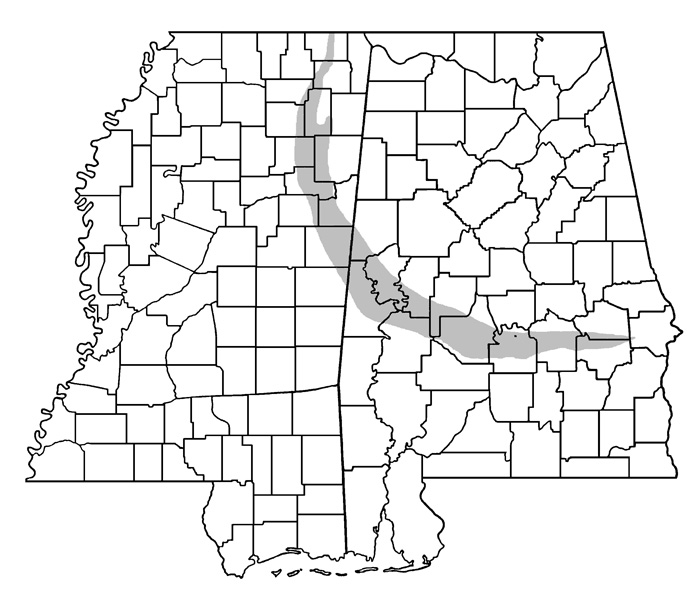Ants of the Black Belt Prairie of Mississippi
JoVonn G. Hill and Joe A. MacGown
The following list includes 52 species. Species on this list are based on collections made by MEM staff since 1991 at various localities within the Black Belt in Alabama and Mississippi, collections at MacGown's home (which is in the Black Belt), and primarily from the research conducted by J. G. Hill in the Black Belt, which culminated in a master's thesis (2006) that dealt with ants of this region. The following list only includes ants found in the prairie region of the Black Belt and does not include those species found in wooded habitats.
The Black Belt is a subdivision of the East Gulf Coastal Plain physiogeographic province. It forms a cresentic region extending from McNary County in extreme southern Tennessee, south through east-central Mississippi and east to Russell County, Alabama near the Georgia state line (see the map below). The region is approximately 310 miles long and up to 25 miles wide, but narrowing at its northern and eastern extremes. The entire region is underlain by Selma Chalk formed from Upper Cretaceous marine deposits. Depending on the exact consistency of the parent material, the chalk weathers into a variety of soil types which supports a mosaic of habitats ranging from prairie to forest. Areas of prairie are typically on well drained, slowly permeable, alkaline soils, whereas the oak-hickory forest of the Black Belt are associated with strongly acidic soils. The Black Belt contains three major plant communities: open prairie, chalk outcrop, and forest. The open prairie habitat includes several endemic (from the Great Plains) and rare species of plants and insects. Go to the MEM Black Belt Prairie web site for more information about this unique and dissappearing habitat.

Map of Mississippi and Alabama showing the general outline of the Black Belt
Clicking on a species name will lead to a page with further information and photographs of that species. Although species pages are at various levels of progress, most pages now have representative photographs of at least workers of the species. In addition to the photographs of ants taken by Joe MacGown at the Mississippi Entomological Museum (MEM), many photos are used, with permission, from AntWeb, a web site about ants of the world with amazing photos. Another site with photographs of ants is "Discover Life." The Discover Life site provides a list of North American ants with photos at "Kinds of Ants, Ants of North America Page". On each individual MEM species page, a link is provided (at the bottom of the page) for that species on both the AntWeb site and the Discover Life ant site.
The list presented is arranged by subfamily, tribe, and genus according to Bolton (2014). For species that are introduced or considered to be pest species, that designation is given following the species name. For species whose origin is uncertain, the word "introduced" is followed by the "?" symbol. Similarly, for questionable pest species, the word "pest" is followed by the "?" symbol. Pest species include species that are considered to be serious pests, in that they may cause significant damage or health problems, to mild, nuisance pests.
Family Formicidae
Subfamily Dolichoderinae
Tribe Dolichoderini
Dolichoderus pustulatus Mayr
Forelius mccooki (McCook)
Linepithema humile (Mayr) (introduced, pest)
Tapinoma sessile (Say) (pest)
Subfamily Formicinae
Tribe Lasiini
Lasius neoniger Emery
Nylanderia arenivaga (Wheeler)
Nylanderia vividula (Nylander) (introduced?, pest)
Prenolepis imparis (Say) (pest?)
Tribe Plagiolepidini
Brachymyrmex depilis Emery
Tribe Camponotini
Camponotus castaneus (Latreille) (pest)
Camponotus decipiens Emery (pest)
Colobopsis impressa Roger
Colobopsis mississippiensis (Smith)
Tribe Formicini
Formica dolosa Buren
Polyergus montivagus Wheeler
Subfamily Pseudomyrmecinae
Tribe Pseudomyrmecini
Pseudomyrmex pallidus (Smith) (pest?)
Pseudomyrmex seminole Ward
Subfamily Ponerinae
Tribe Ponerini
Hypoponera inexorata (Wheeler)
Hypoponera opaciceps (Mayr)
Hypoponera opacior (Forel)
Ponera pennsylvanica Buckley
Subfamily Proceratiinae
Tribe Proceratiini
Proceratium pergandei (Emery)
Subfamily Myrmicinae
Tribe Stenammini
Aphaenogaster carolinensis Wheeler
Aphaenogaster flemingi Smith
Aphaenogaster treatae Forel
Tribe Solenopsidini
Monomorium minimum (Buckley) (pest)
Solenopsis invicta Buren (introduced, pest)
Solenopsis invicta x richteri (introduced, pest)
Solenopsis molesta (Say) (pest)
Solenopsis picta Emery
Tribe Attini
Cyphomyrmex rimosus (Spinola) (introduced)
Pheidole bicarinata Mayr (pest?)
Pheidole dentata Mayr (pest?)
Pheidole lamia Wheeler
Pheidole pilifera (Roger)
Pheidole tysoni Forel
Strumigenys bimarginata Wesson & Wesson (MS, NC)
Strumigenys creightoni Smith
Strumigenys dietrichi Smith
Strumigenys louisianae Roger
Strumigenys margaritae Forel (introduced)
Strumigenys membranifera Emery (introduced)
Strumigenys ornata Mayr
Strumigenys talpa Weber
Trachymyrmex septentrionalis (McCook)
Tribe Crematogastrini
Crematogaster ashmeadi Mayr (pest)
Crematogaster lineolata (Say) (pest)
Crematogaster missuriensis Emery
Crematogaster pilosa Emery (pest)
Myrmecina americana Emery
Temnothorax curvispinosus (Mayr)
Temnothorax pergandei (Emery)
Bolton, B. 2014. An online catalog of the ants of the world. Available online: http://www.antweb.org/world.jsp (accessed 31 October 2014).
Hill, J. G. 2006. Environmental Variables Affecting Ant Community Composition in Mississippi's Black Belt Prairie and Flatwoods Regions. Masters Thesis, Mississippi State University. 72 pp. [pdf]


